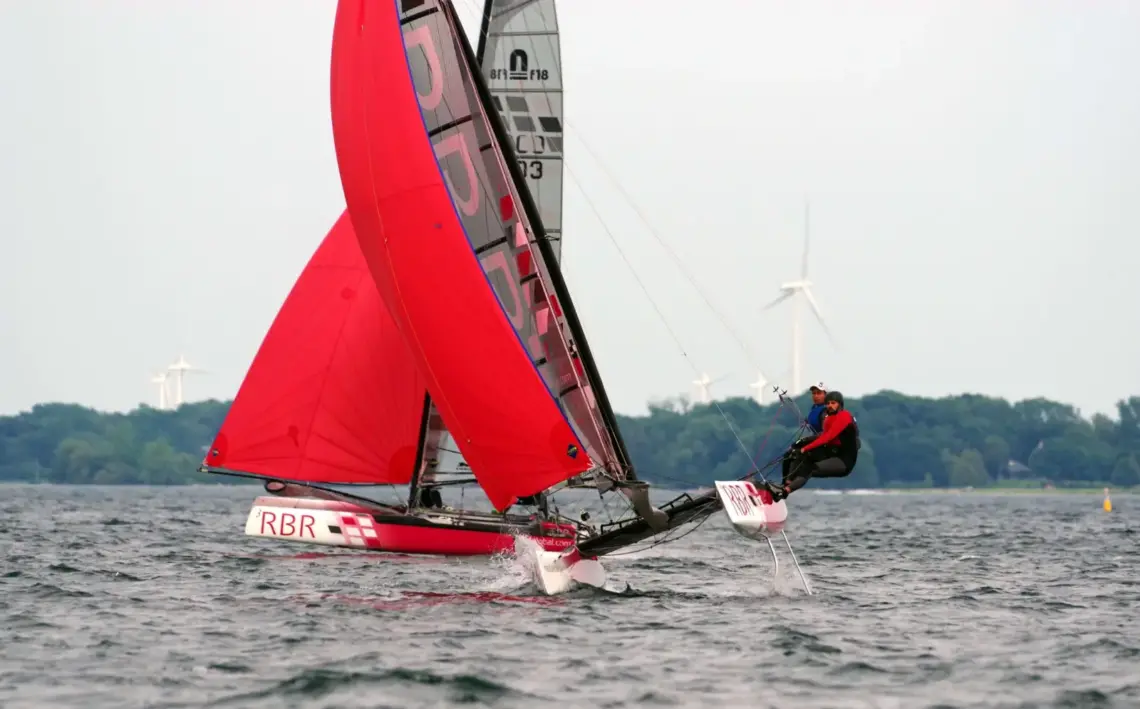
Whether he’s working with water or playing on it, Greg Johnson – engineer, entrepreneur and executive – is all about pushing the boundaries of technology and science.
Johnson is president of Kanata North’s RBR Ltd. Since the 1990s, this 48-year-old company has been designing and building instruments that help scientists and researchers around the world measure different parameters in ocean water.

But Johnson has another passion – racing catamarans. Or to be more precise, the Dutch-built Nacra F18 catamaran. This 5.5-metre-long sailboat has a crew of two dangling over the water on trapeze rigs. Thanks to advances in carbon fibre materials, these craft can easily rise out of the water on their daggerboards and hydrofoil rudders.
That makes these catamarans fast. When a crew has a wipeout, it’s epic.
“The Ottawa River is not as large as you think when travelling at 25 knots (46 kph),” Johnson said. “We have discovered every rock in the river but should add the disclaimer that ‘no rock has been harmed’.”
So, why did he take up the sport?
An ex-pat Brit who has split his life between Canada, the U.K. and France, Johnson sailed dinghies as a boy. He became a volunteer lifeguard in the U.K., “to ensure I had enough skills to not require rescuing on the sea.”
As an adult, Johnson became an engineer. He first went to work at RBR as director of engineering under his father, before taking over the reins as president 11 years ago. Then came a point that had him re-evaluating where he was in life.
“When I turned 40, I thought I should have a mid-life crisis – figured I should manufacture one instead of waiting for it.” Johnson decided a catamaran was a better choice than a motorcycle, because when you wipe out, it’s a lot less painful to hit water than it is to hit asphalt.
To make it more competitive and fun, he has two Nacra F18s on the water and has created the RBR Flight School (yes, aficionados call this flying, not sailing), for anyone who wants to learn to operate these craft. The boats are named Loon and Gannet after the water birds, aka RBR 3 and RBR 4 (the previous presidents of RBR had claimed the vanity licence plates RBR 1 and RBR 2, so Johnson decided to continue the tradition on the water).

These are the only two craft of their kind in eastern Ontario, but there are of course other sailing enthusiasts and other sailboats on local waters. Johnson spends part of his summer participating in various sailing events across the region.
“We are not particularly good sailors, but we do enjoy ourselves quite a lot,” he said. “Sailing is a great combo of art and science. It’s a great way to be outdoors. These types of boats have an athletic component which is good for me.”
Taking the measure of ocean water
As an engineer, Johnson has always been interested in instrumentation, which led him to join his father at RBR. From the ocean abyss to the polar ice cap, RBR sensors track water parameters: temperature, depth, salinity, dissolved gases, pH and many others.
RBR’s instruments support the study of climate change and environmental sustainability, and projects for environmental remediation in response to industrial activity.
It’s a high-precision science. Take temperature. Where measurements in tenths of a degree are sufficient for air temperature, the study of ocean water for climate change science requires granularity in the thousandths of degrees.
According to Johnson, RBR doesn’t operate in a niche market, but in a “micro-niche” one. There are only six players in the global market for such precise oceanographic instrumentation. RBR’s team is always looking at how it can continue to push the state of the art.
“What pervades RBR is a dissatisfaction with the status quo,” Johnson said. “Whatever the current state, and to some people’s irritation, I can always look at something from the perspective of what can be improved.”
When RBR found itself beginning to plateau on the functionality and accuracy of its instruments, it turned its attention to improving ease of use. Several of RBR’s competitors are older shops that continue to market a generation of instruments that require a “lot of TLC” and technical skill to use effectively.
“An instrument should be as simple to operate as your phone and hide all its complexity on the inside,” Johnson said. “Our aspirational goal is to make instruments that you don’t have to be an expert to use, even though they provide expert-level data.”
The need for this kind of tech has been growing. In fact, in the five years before the pandemic dampened demand, RBR enjoyed 20 per cent annual growth. About 80 per cent of its revenue comes from exports, to just about any country with a coastline.
But while most of RBR’s business is overseas, R&D and manufacturing takes place here in Kanata North. The “special sauce” comes with the final assembly and the calibration of each instrument.
“We can be nearly 2,000 miles away from an ocean and be an oceanographic instrument company without having saltwater at our doorstep,” Johnson said. “RBR is all about growing the connection with the next generation of researchers … we are really thinking about the long-term future of the company, and who our customers will be in the decades to come.”
By Leo Valiquette, lead photo by Geoff Webster of Photo One
